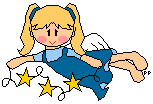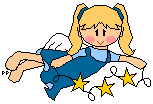 |
Daily Care |
|
When our girls were diagnosed with the severest form of
Spinal Muscular Atrophy we decided to be very aggressive in their
care. We talked to many families with children with SMA as well
as doctors and therapists. We listened to everyone and then decided
on a plan of action that we were comfortable with. One of the
most difficult problems in dealing with SMA is realizing that
there is no proven protocol in the care of children with SMA.
The medical community is very diversified in their approach,
especially the care
for type 1 children.
Every child is different, what works for one family may
not work for another. Educate yourself, talk with your doctors
and decide on what course is right for you and
your family.
We were told type 1 children typically do not survive past
the age of two because of their weak respiratory systems. They
usually have a very weak swallow and cough. A cold can be lethal
to these children. They can not handle the added secretions that
a cold brings and pneumonia can develop. We addressed their respiratory
care as our top priority.
Below is a summary of the girls daily care:
Respiratory Care –The girls use
a noninvasive respiratory protocol under the guidance of Dr.
John Bach of Newark, New Jersey. The girls have respiratory
treatments at least 3 times a day which consists of percussions,
suction, and breaths with the in-exsuffalator.
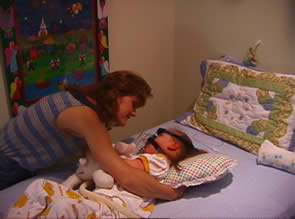 |
Bi-pap Ventilatory Support - They began using Bi-pap
when they were 1 year old. We knew they needed it because
they had trouble with night sweats and were very restless
during the night. Their oxygen saturations would also fall
below 95% during sleep before they started Bi-pap. The
Bi-pap assists breathing and allows the respiratory muscles
rest so they are stronger the next day.
Pulse Oximeter – We use
this to measure the girl’s oxygen saturation levels.
Their levels should be 95% or higher. We know when their
levels stay below 95% that there is a respiratory problem.
|
In-exsuffalator – This
is used to give an assisted cough and bring up secretions from
their lungs. A suction machine is then used to clear the secretions.
Due to their respiratory weakness, they are unable to produce
an effective cough. This piece of equipment helps not only to
cough, but also to expand their lungs to keep them healthy. It
is used as range of motion for the lungs.
Percussions and postural drainage – We
do percussions and postural drainage to help clear the girls
lungs. We also use a nebulizer with albuetrol
at least once a day. We have learned to listen for breath sounds
with a stethoscope to determine if the girl’s lungs are
clear.
Illnesses and Respiratory Distress
| Times of illness are always very trying for the girls.
Sometimes they have to be hospitalized to help them through
a respiratory infection. Increased secretions, trouble breathing,
congested airways, and oxygen saturations staying below 95%
are indicators of an illness for them. The girls have been
intubated due to pneumonias. When this occurs we follow a
strict protocol for extubation which requires intense respiratory
treatments for a least 48 hours.
We use oxygen at times of Respiratory Distress, but
are very cautious with its use. The use of oxygen can be
very deceiving. When saturations are going up with the use
of oxygen, it could be believed that the girls are getting
better. However, it could be masking the problem and secretions
need to be cleared from their lungs with good cough techniques
to improve ventilation. Also CO2 levels should be considered.
If breathing muscles are weak, the amount of CO2 may not
be properly eliminated and levels could build up. |
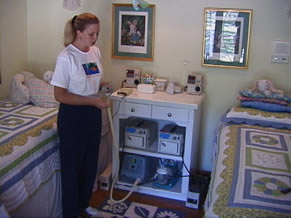 |
Diet
The girls are fed through gastrointestinal tubes. They
were breast feed until they were 10 months old. They then started
developing swallowing problems. They had the g-tube and the Nissen
Fundolplication when they were 13 months old. They did not do
well on formulas like Pediasure, so we switched them to an amino
acid formula, Pediatric Vivonex. They do very well on this elemental
formula. We mix it with juice, baby food, and some other things
that we have found helpful. We are very specific with their protein
and calorie intake and adjust it to their weight.
We have also found that extra water is also important.
It helps to keep secretions thin and helps with constipation.
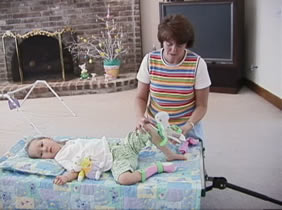 |
Therapy
Physical therapy – The girls have a physical
therapist work with them once a week to help with stretching,
range of motion, seating and positioning issues. Our
family does physical therapy with the girls everyday.
We do stretching in the morning and range of motion.
But all during the day as we play with them we are bending
their legs, stretching their little fingers and moving
their bodies. They love the hands on and hate to lay
still any length of time. They also use a stander to
help with weight bearing and an opportunity to see the
world upright. |
Occupational therapy - The girls have two occupational
therapists that each come to our house once a week. They help
them use their hands for daily living activities as well as activities
with the computer and artwork and so forth. To help give them
more arm movement we use arm slings attached to a small A frame
(picture of them using their arm slings under Pictures).
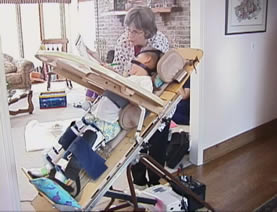 |
Speech Pathology
Speech pathologist - This person helps with speech
and language. We try to do mouth stretching exercises
everyday. The girls are three ½ and have just started
to talk. Other families have told us that their children
talked much earlier.
Water therapy- This type
of therapy is a lot of fun for the girls and it has been
a tremendous help for them. They have a small heated
pool that they swim in three to four times a week. The
buoyancy of the water allows them to move their bodies
freely in the water. It is great exercise for them.
Preschool teachers – Our
local school system has been very helpful and supportive
with the girls. Teachers come to our house twice a week
for school. They do various activities with the girls
and really enhance their cognitive skills.
|
Seating – The girls have a
kidkart that they use for seating as well as new powerchairs.
They activate the chairs by infra red and proximity switches.
It allows them a freedom of independence that is so important.
They also enjoy moving around in their motorized scooterboard
that they are able to activate with a switch.
Lastly, we feel that it is very important for the
girls to experience many different things just like other
children their age. They enjoy the outdoors and love riding
in their wagons and swinging in the hammock. They are just
beginning to enjoy some independence working on their computer
and activating switches to make things work. Also, we try
very hard to help them overcome their limitations by assisting
them in task. They love playing games like Candyland and
matching cards. They love country music and Disney movies.
They are very intelligent little girls and learn very quickly.
They learned from the very beginning they must fight to
survive. They have become true fighters. They are also
very happy children who love all of the simple pleasures
in life. They have taught us so much. |
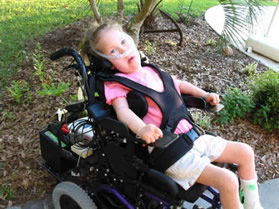 |
Disclaimer: Please realize that this is not medical
advice. All information contained in this web site is intended
for informational purposes only and is not intended to replace
and should not be interpreted or relied upon as professional
advise. It is strongly recommended that you consult a
physician to assess individual conditions and needs. |


